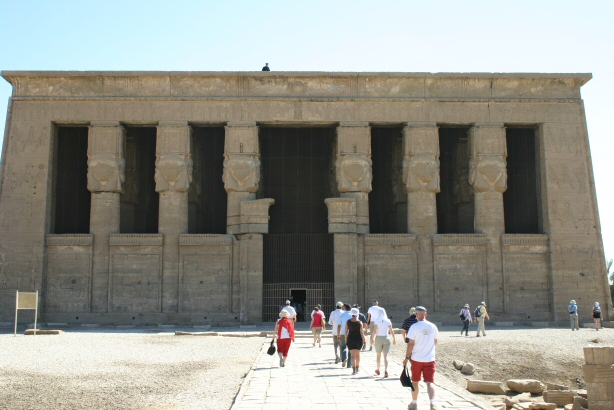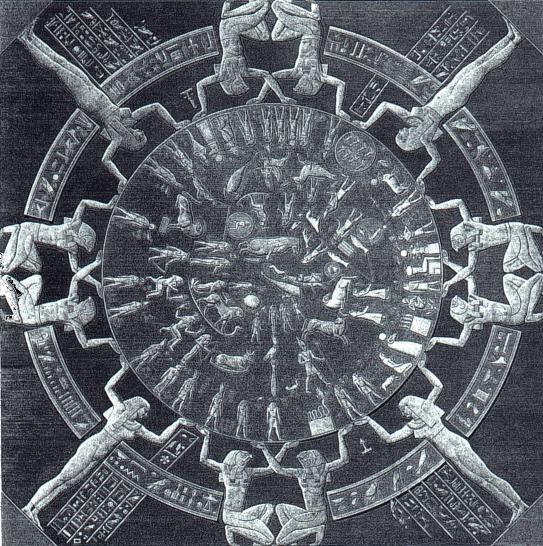
EL MARAVILLOSO EGIPTO - CORREO
Creado por juancas correo del 25 de Noviembre del 2009
Dendera
From Wikipedia, the free encyclopedia
Coordinates: 26°10′N 32°39′E / 26.167°N 32.65°E
| Dendera | |
|---|---|
| General view of the temple compound. | |
| | |
| Coordinates: 26°10′N 32°39′E / 26.167°N 32.65°E | |
| Country | |
| Governorate | Minya Governorate |
| Time zone | EST (UTC+2) |
| - Summer (DST) | +3 (UTC) |
Dendera (Arabic: دندرة; also spelled Denderah, Dandarah, Tentyra[1]), is a little town in Egypt on the west bank of the Nile, about 5 km south from Qina, on the opposite side of the Nile.
[edit] History
Located rather isolated on the desert edge, about 2.5 km south-west of the Town, lay what Dendera is known for, the mostly Greco-Roman Temple Complex, Dendera, known in ancient Egyptian as Iunet or Tantere. The modern Arab town is built on the ancient site of Ta-ynt-netert which means 'She of the Divine Pillar', or Tentyra which is Greek for Dendera. It was once the capital of the 6th Nome (Pharaonic province) of Upper Egypt, also named Nikentori or Nitentori, which signifies willow wood or willow earth. Others give the derivation from the sky and fertility goddess Hathor, also associated with the Greek Aphrodite, who was specially worshiped there. The crocodile is recognized as the deity of the city and was also venerated as such in the other Egyptian cities, which caused many quarrels, notably with Ombos. It is still the seat of a titular see, suffragan of Ptolemais, in the former Roman province of Thebaid Secunda. Little is known of Christianity in that place, as only the names of two ancient bishops are given: Pachymius, companion of Melece at the beginning of the fourth century; and Serapion or Aprion, contemporary and friend of the monk St. Pachomius, who had in his diocese his celebrated convent of Tabennisi. It became the Arab Denderah, under late Ottoman rule a town of 6000 inhabitants in Qina.
[edit] The Temple
The Dendera Temple complex which contains the Temple of Hathor is one of the best preserved temples, if not the best, in all Egypt. The whole complex covers some 40,000 square meters and is surrounded by a hefty mud brick enclosed wall. The present building dates back to the times of the Ptolemaic dynasty and was completed by the Roman emperor Tiberius, but it rests on the foundations of earlier buildings dating back at least as far as Khufu (pyramid builder Cheops, second king of the 4th dynasty [c. 2613–c. 2494 BC]), in which was found the celebrated zodiac now in Paris; there are also the Roman and pharaonic Mammisi (birth houses), ruins of a Coptic church and a small chapel dedicated to Isis, of the Roman or Ptolemaic epoch. The area around the temple has had extensive landscaping, and now has a modern visitor centre, bazaar and small cafeteria.
[edit] References
"Tentyris". Catholic Encyclopedia. New York: Robert Appleton Company. 1913. http://www.newadvent.org/cathen/14512b.htm.
This article incorporates text from the entry Tentyris in the public-domain Catholic Encyclopedia of 1913.
Dendera
De Wikipedia, la enciclopedia libre
Dendera fue capital del nomo VI del Alto Egipto. La ciudad está situada en la ribera oriental del río Nilo, unos 70 km al norte de Luxor.
- Nombre egipcio: Iunet o Tantere. Nombre griego: Tentyris. Nombre árabe: Dendera.
Contenido
|
El templo de Hathor [editar]
La construcción del templo fue iniciada por Nectanebo I, se continuó y decoró en el periodo ptolemaico y se terminó en época romana.
Tiene dos salas hipóstilas y el "patio del año nuevo" con capiteles hathóricos.
Dentro del templo hay doce criptas decoradas, y dos capillas funerarias de Osiris, de una de ellas procede el célebre "zodiaco" que se expone en el Museo del Louvre, en París.
En el tejado había una capilla donde se celebraba el rito de la unión de la diosa Hathor con el disco solar.
Un gran muro de adobes rodea el recinto con una puerta monumental de Domiciano y Trajano.
Al sur del templo de Hathor, se halla el templo del nacimiento de Isis, decorado en tiempos de Augusto. En el entorno se encuentran el mammisi de Nectanebo I, el mammisi romano, un lago sagrado y un sanatorio.
La necrópolis de Dendera [editar]
Con importantes tumbas del Imperio Antiguo y el primer periodo intermedio de Egipto.
Los nobles construyeron amplias mastabas, en una de ellas se conserva la decoración, estelas y "falsas puertas".
Hay catacumbas con bóvedas de ladrillo y tumbas de animales, predominando las de pájaros, perros y vacas (que simbolizaban a la diosa Hathor)
- En los "Misterios de Osiris", Dendera fue una de las tumbas de Osiris, celebrándose allí la representación ritual de su resurrección.
| Iunet Iunt en jeroglífico |
|
Véase también [editar]
Enlaces externos [editar]
 Wikimedia Commons alberga contenido multimedia sobre Dendera.
Wikimedia Commons alberga contenido multimedia sobre Dendera.- Situación:
- Dendera, en institutoestudiosantiguoegipto.com
Dandara (Dendera)
Gastón Maspero dirigió el Service d'Antiquités Egyptiennes y escribió sobre el collar de Menes, por primera vez.

LISTA DE REPRODUCCIÓN - PLAYLIST
- JESUCRITO I - viernes 13 de enero de 2012
- Mundo Religioso 1 - miércoles 28 de diciembre de 2011
- Mundo Religioso 2 - jueves 29 de diciembre de 2011
- Mitología Universal 1 (Asturiana) - jueves 29 de diciembre de 2011
- El Narrador de Cuentos - UNO - jueves 29 de diciembre de 2011
- El Narrador de Cuentos - DOS - jueves 29 de diciembre de 2011
MEDICINA NATURAL, RELAJACION
- Medicina Natural - Las Plantas Medicinales 1 (Teoría) - miércoles 28 de diciembre de 2011
- Medicina Natural - Plantas Medicinales 1 y 2 (Visión de las Plantas) - miércoles 28 de diciembre de 2011
- Practica de MEDITATION & RELAXATION 1 - viernes 6 de enero de 2012
- Practica de MEDITATION & RELAXATION 2 - sábado 7 de enero de 2012
VAISHNAVAS, HINDUISMO
- KRSNA - RAMA - VISHNU - jueves 16 de febrero de 2012
- Gopal Krishna Movies - jueves 16 de febrero de 2012
- Yamuna Devi Dasi - jueves 16 de febrero de 2012
- SRILA PRABHUPADA I - miércoles 15 de febrero de 2012
- SRILA PRABHUPADA II - miércoles 15 de febrero de 2012
- KUMBHA MELA - miércoles 15 de febrero de 2012
- AVANTIKA DEVI DASI - NÉCTAR BHAJANS - miércoles 15 de febrero de 2012
- GANGA DEVI MATA - miércoles 15 de febrero de 2012
- SLOKAS y MANTRAS I - lunes 13 de febrero de 2012
- GAYATRI & SHANTI MANTRAS - martes 14 de febrero de 2012
- Lugares Sagrados de la India 1 - miércoles 28 de diciembre de 2011
- Devoción - PLAYLIST - jueves 29 de diciembre de 2011
- La Sabiduria de los Maestros 1 - jueves 29 de diciembre de 2011
- La Sabiduria de los Maestros 2 - jueves 29 de diciembre de 2011
- La Sabiduria de los Maestros 3 - jueves 29 de diciembre de 2011
- La Sabiduria de los Maestros 4 - jueves 29 de diciembre de 2011
- La Sabiduría de los Maestros 5 - jueves 29 de diciembre de 2011
- Universalidad 1 - miércoles 4 de enero de 2012
Biografías
- Biografía de los Clasicos Antiguos Latinos 1 - viernes 30 de diciembre de 2011
- Swami Premananda - PLAYLIST - jueves 29 de diciembre de 2011
Romanos
- Emperadores Romanos I - domingo 1 de enero de 2012
Egipto
- Ajenaton, momias doradas, Hatshepsut, Cleopatra - sábado 31 de diciembre de 2011
- EL MARAVILLOSO EGIPTO I - jueves 12 de enero de 2012
- EL MARAVILLOSO EGIPTO II - sábado 14 de enero de 2012
- EL MARAVILLOSO EGIPTO III - lunes 16 de enero de 2012
- EL MARAVILLOSO EGIPTO IV - martes 17 de enero de 2012
- EL MARAVILLOSO EGIPTO V - miércoles 18 de enero de 2012
- EL MARAVILLOSO EGIPTO VI - sábado 21 de enero de 2012
- EL MARAVILLOSO EGIPTO VII - martes 24 de enero de 2012
- EL MARAVILLOSO EGIPTO VIII - viernes 27 de enero de 2012
La Bíblia
- El Mundo Bíblico 1 - lunes 2 de enero de 2012 (de danizia)
- El Mundo Bíblico 2 - martes 3 de enero de 2012 (de danizia)
- El Mundo Bíblico 3 - sábado 14 de enero de 2012
- El Mundo Bíblico 4 - sábado 14 de enero de 2012
- El Mundo Bíblico 5 - martes 21 de febrero de 2012
- El Mundo Bíblico 6 - miércoles 22 de febrero de 2012
- La Bíblia I - lunes 20 de febrero de 2012
- La Bíblia II - martes 10 de enero de 2012
- La Biblia III - martes 10 de enero de 2012
- La Biblia IV - miércoles 11 de enero de 2012
- La Biblia V - sábado 31 de diciembre de 2011
Canales youtube: danielcap7, contreraspicazoa canaldesolopredica mayte37 ElOcasodelaRealidad NylaRossini elmisionero3000 christianfilmclub sergio13969586 MultiManuel37 89SuperJazzman rusmeo Revolutionministery kokinb84 prenpeace2 jespadill
Canales tu.tv: de danizia, bizzentte, santiagooblias


TABLA - FUENTES - FONTS
- SOUV2P.TTF - 57 KB
- SOUV2I.TTF - 59 KB
- SOUV2B.TTF - 56 KB
- SOUV2T.TTF - 56 KB
- bai_____.ttf - 46 KB
- babi____.ttf - 47 KB
- bab_____.ttf - 45 KB
- balaram_.ttf - 45 KB
- SCAGRG__.TTF - 73 KB
- SCAGI__.TTF - 71 KB
- SCAGB__.TTF - 68 KB
- inbenr11.ttf - 64 KB
- inbeno11.ttf - 12 KB
- inbeni11.ttf - 12 KB
- inbenb11.ttf - 66 KB
- indevr20.ttf - 53 KB
- Greek font: BibliaLS Normal
- Greek font: BibliaLS Bold
- Greek font: BibliaLS Bold Italic
- Greek font: BibliaLS Italic
- Hebrew font: Ezra SIL
- Hebrew font: Ezra SIL SR
Disculpen las Molestias

EGIPTOLOGÍA
| 2007 | CORREO 2007 (193)SC • 11SK • 80EA • 901SC • |
| 2008 | CORREO 2008 (609)SC • 1566JC • 1135SC • 1134SC |
| 2009 | Egiptología - URL Año 2009 |
| 2010 | Egiptología - URL Año 2010 |
| 2011 | ENERO | FEBRERO | |
| Antiguedad | Faraones (1) (1158)SC • Faraones (2) (1407)SC • Dinastía (1408)SC • Egyptian pantheon o Dioses egipcios (4922)JC |
TABLA de Greek Mythology
TABLA de Mitología Romana
TABLA de Otras Ramas de Mitología
TABLA - Religión Católica
- Religión Católica
- PAPAS - POPES
- MITOS DE LA BIBLIA
- Via Crucis desde Roma - 10/04/2009 (Completo) (www.populartv.net Oficiado por su Santidad el Papa Benedicto XVI). Papa Juan Pablo II (Karol Wojtyla). (Rosarium Mysteria Gloriosa | Rosarium Mysteria Doloris
- Rosarium Mysteria Gaudii)
- CATHOLIC RELIGION (2020)SK
- Category:Roman Catholicism (3219)SK
- Catolicismo (3220)SK
- Pope o Papas (3243)SK 3. Handel: Brockes Passion, HWV 48 / Marcus Creed (OedipusColoneus) (3243)SK http://www.youtube.com/watch?v=QkBV6tEmYx8 4. Handel: Brockes Passion, HWV 48 / Marcus Creed (OedipusColoneus) (3243)SK http://www.youtube.com/watch?v=xM3Y5CxvKcg
- Category:Popes (3221)SK
- Listado de Papas desde Pedro hasta el presente (738)EA2
- Catholics
- Misa del Santo Padre Benedicto XVI en la Beatificación del Papa Juan Pablo II
- Juan Pablo II, nuevo beato
- Santos Católicos
- Beato Juan Pablo II - Su Peregrinaje y Su Vida - 1978 al 1986
- Catholics
Vaishnavas
- Sri Garga-Samhita
- Oraciones Selectas al Señor Supremo
- Devotees Vaishnavas
- Dandavat pranams - All glories to Srila Prabhupada
- Hari Katha
- SWAMIS
General
- JUDAISMO
- Buddhism
- El Mundo del ANTIGUO EGIPTO II
- El Antiguo Egipto I | Archivo Cervantes | Sivananda Yoga
- Neale Donald Walsch
- ENCICLOPEDIA - INDICE
- DEVOTOS FACEBOOK
- EGIPTO - USUARIOS de FLICKR y PICASAWEB
- Otros Apartados
- Mejoras
- MULTIPLY y OTRAS
- juancastaneira - JC
- sricaitanyadas - SC
- srikrishnadas - SK
- elagua2 - EA2
- elagua - EA
- casaindiasricaitanyamahaprabhu - CA







![N35 [n] n](http://es.wikipedia.org/w/extensions/wikihiero/img/hiero_N35.png)
![X1 [t] t](http://es.wikipedia.org/w/extensions/wikihiero/img/hiero_X1.png)



No hay comentarios:
Publicar un comentario